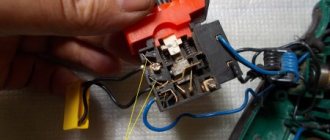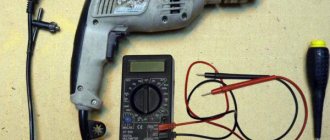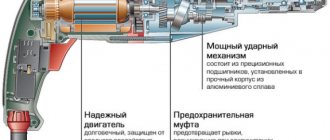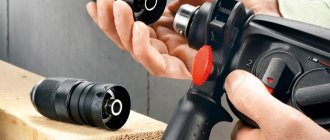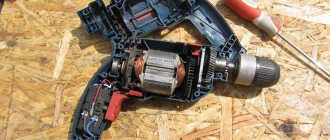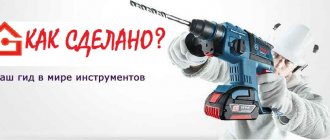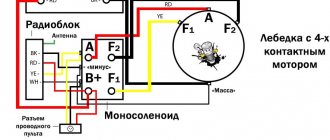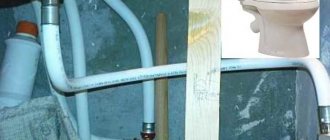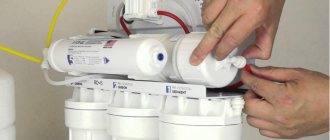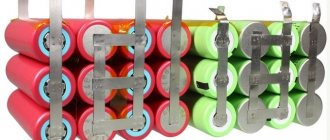How to disassemble a hammer drill button if it is broken - repair review
Professional construction tools always work in extreme conditions, therefore both the mechanical and electrical parts of the hammer drill have an increased working life.
As practice shows, tools from brands such as Makita, Bosch or Interskol rarely fail during the warranty period, but sooner or later everything breaks.
One of the most vulnerable places of any rotary hammer is the power button with speed control and reverse switch.
There are three types of button failure:
How to check the start button of a hammer drill ?
To do this, you can use an electric multimeter (tester): you need to connect to the ends of the hammer drill fork and press the start button.
If the multimeter shows the presence of resistance, then the power tool circuit is intact. The absence of resistance indicates a violation of the integrity of the circuit.
At the same time, you need to understand that the problem may not only be in the switch button. You should also check the electrical cable for kinks, wear on the carbon brushes and reverse switch contacts.
This is the only way to be sure that the reason lies in the switch.
Frequent breakdowns
Many years of experience of craftsmen shows that when solving a problem - why a hammer drill does not work - the cause can be found in almost any node.
This makes it difficult or completely impossible to attempt to independently diagnose and repair the instrument, although in some cases the breakdown is simple.
For example, if a hammer drill does not work in a vertical position, then with a 99% probability the cause lies in a break in the power cord at an area of 10-20 cm from the entrance to the tool and can be eliminated within a few minutes.
If a Bosch, Metabo, etc. hammer drill does not turn on, the reasons are also usually caused by a breakdown of the electrical part:
- a break in the power cable, a defective plug or power button - this is most often caused by a short circuit in the filter capacitor;
- wear or destruction of commutator brushes;
- loosening the screws of the electrical contacts;
- contamination or burnout of the collector lamellas;
- breakdown of the turns of the armature or stator winding;
- failure of the operating mode switch due to contamination.
The list of mechanical failures is even more extensive and, as a rule, requires the replacement of defective parts with new ones with similar characteristics. Any of the “Udachnaya Tekhnika Service” workshops can quickly, inexpensively and with a quality guarantee repair Bosch and other rotary hammers.
Electrical faults
Before disassembling the hammer drill, you need to find out what is causing the malfunction.
After all, if a hammer drill refuses to work, then the reason may be hidden in a banal lack of voltage in the outlet. That's right, troubleshooting should start from smallest to largest. If the tool does not function and does not show any signs of life, then the reason is 100% hidden in the electrical part. Let's look at the main types of faults in the electrical part of the hammer drill, and also find out the features of their elimination.
- No network and damaged network cable. First you need to make sure that there is voltage in the outlet. This can be done by connecting any other household appliance. During the work, the power cable could be accidentally broken with a hammer drill. As a result of broken contact in the wire, the tool will not function. The situation can be corrected by replacing the wire or restoring its integrity. To determine such a breakdown, you should use a tester in dial mode.
- Start button malfunction. The cause of the malfunction may be banal oxidation of the contacts in the start button. To do this, you need to remove the back cover of the tool. If no visible violations of the button are detected, then you can check its serviceability with a multimeter. You can clean the contacts or replace the button assembly.
- Washing brushes. The brush assembly belongs to the category of replaceable parts, therefore, if the brushes are significantly abraded, sparks and a burning smell may be observed. The length of the brush should not be less than 8 mm, so they must be replaced. To replace the commutator brushes, it is necessary to remove worn parts and then install new ones in their place. Replacing electric motor brushes is not often done, since their design is made of graphite. The more often the tool is used, the less frequently the brushes need to be replaced.
- Damage to the speed controller. In this case, the entire assembly should be replaced. But this type of breakdown is quite rare.
- Motor malfunction. This is the worst thing that can happen to a power tool. A burnt-out electric motor can only be repaired in specialized workshops. But you shouldn’t make hasty conclusions about a motor malfunction. After all, the reason for its non-functioning may be carbon deposits on the collector. Oxides and carbon deposits should be removed, and then a test run should be carried out. If in this case nothing helps, then you need to ring the motor armature using a tester. The interturn resistance must have a certain value. If a short circuit is detected or if the device shows infinity, the armature must be replaced or repaired in a workshop. The reason may also be a malfunction of the stator, which also consists of copper windings. The presence of a break or short circuit is checked in the same way using a multimeter.
Don't Miss: Magnetic Drilling Machine: Types of Magnetic Drilling Machines
The stator winding can be rewound at home if you have an idea of its functioning. Rewinding the stator will cost several times less than buying a new electric motor.
It is important to know! When disassembling a power tool, remember that it must be disconnected from the mains.
Mechanical breakdowns
Disassembling the hammer drill may also be necessary if mechanical breakdowns occur. Before proceeding with repair actions, you must first make sure that the breakdown lies precisely in the mechanics of the hammer drill. Let's consider the main points of mechanical malfunctions of a rotary hammer, as well as the features of their elimination:
- Gearbox malfunction. The lack of diagnostic procedures in frequent cases leads to the failure of any part of the gear mechanism. It is necessary to disassemble the tool and then determine the type of malfunction. At the end of the repair work, the gearbox should be lubricated, having first cleaned it of the previous one.
- Cartridge malfunction. If the nozzle does not clamp, then the reason should be sought in the cartridge. In this case, there is no need to disassemble the entire tool. Often, failures in the cartridge occur due to clogging of the inside. The hammer drill chuck can be repaired if all internal parts are intact.
- The mode switch is faulty. It is necessary to disassemble and identify why the switching of modes between drilling and jackhammer does not occur.
These are the main mechanical components that can cause tool malfunction. In addition, there are other types of mechanical failures, depending on the reasons.
- No impact hammer mode. If the drill rotates together with the chuck, then the floating bearing is the cause of this problem. To resolve the problem you will need to replace it. If the cause of the problem does not lie in the floating bearing, then overload could cause the steel striker to split. In such a situation, it is necessary to replace the striker. Another reason for weakening shocks may be wear of the piston group. In this case, you need to replace the broken part.
- The chuck does not rotate. If, when starting the device, the hum of the electric motor is heard, but there is no rotation of the shaft, then the cause may be a jammed gearbox. You cannot keep the tool turned on in this mode, as the motor will burn out. It is necessary to disassemble the tool and identify the cause of the jamming.
- The drill does not stay in the chuck. The cartridge needs to be repaired.
- The hammer drill does not hold the chuck. Sometimes this happens, so it's important to be alert. If the nozzle comes off together with the cartridge, then the cause is wear of the fastener housing. The situation can be corrected by installing a new retaining ring.
Engine problems
The rotary hammer motor also has a standard design and is not much different from most single-phase commutator electric motors for power tools. The motor stator does not deserve special attention and fails quite rarely. The only thing worth mentioning is that in some models the stator is rigidly fixed in the housing shell and to inspect the engine you will have to disassemble both the tail section with the brush pockets and the front connection to the gearbox.
The drive gear of the gearbox is attached to the rotor shaft on one side, followed by a bearing and a cooling impeller, a magnetic core with windings, a collector current collector and another bearing. The most vulnerable parts of this assembly are the bearings, which are mostly maintenance-free and have a short service life due to operation at high speeds. Their wear is accompanied by the appearance of extraneous noise during operation, vibration and heating of the seats. To replace the bearings, you need to pull them off the ends of the shaft using a puller or a slingshot mandrel, and then install new ones, having previously warmed them with a hairdryer. Don't forget to replace the spacers and o-rings in the correct position.
Another armature element that often fails is the impeller. The entry of large stones through the air intake causes the blades to break off, and sometimes even completely destroy them. In this case, debris and debris get inside the motor, scratch the varnish on the winding wires, and the lack of normal airflow leads to permanent overheating of both parts of the engine. For some motors, it is possible to remove and press on a new impeller, but most armatures have to be replaced as an assembly. This is partly reasonable, because without normal cooling the anchor remains viable for a few minutes.
Damage to the insulation of the windings can cause a short circuit between the turns, which leads to a change in resistance and uneven operation of the motor. The stator resistance can be measured using two lead wires; it should be equal to the nameplate value. Measurements of the armature windings are carried out between two lamellas, and the values may deviate slightly from the passport data, but all windings must have equivalent conductivity.
Short circuits in the windings can be easily identified by the characteristic blackening of the varnish in places of overheating and burning. The black varnish no longer serves as an insulator; such an engine must be replaced immediately. Basically, maintenance of the electric motor comes down to blowing it out of dust, as thoroughly as possible, and cleaning the collector of graphite dust and carbon deposits.
Repair instructions - replacing and connecting a hammer drill button using the example of Makita 2450
Most MAKITA rotary hammers (models HR2020, 2432, 2440, 2440F, 2450, 2455, 2475 and 2641) use a standard TG813TLB-1 series switch.
To inspect and/or replace it, you need to prepare the following tools:
The procedure for repairing/replacing the power button on a Makita 2450 rotary hammer is as follows:
VIDEO INSTRUCTIONS » alt=»»>
Useful tips
Often even professional equipment quickly breaks down. This occurs due to the operation of the tool with significant overload of the electric motor. The power unit must not be allowed to overheat; technological breaks must be taken periodically. Sometimes serious damage to a hammer drill is a consequence of careless handling of the tool during operation or during storage.
After each use, it is necessary to thoroughly clean the rotary hammer from dust. Use a soft cloth or napkin to wipe not only the body of the power tool, but also the ventilation slots.
Do not use the hammer drill outdoors during rain or snow.
Carbon brushes, which are an important part of the electrical circuit, should be regularly inspected - they conduct current to the commutator and during operation gradually wear out and require replacement.
You should not buy non-original components of questionable quality, which can lead to more significant breakdowns.
Source
Types of drills for hammer drills
It should be immediately noted that a drill is an accessory for a drill, and a drill is used in rotary hammers. The difference is explained by the fact that the hammer drill makes holes, but does it with simultaneous chiselling, that is, drilling is obtained.
- chisel;
- drill;
- lance or chisel lance;
- channel drill;
- crown.
The chisel is designed for removing plaster, tiles, tiles or any other worn-out coating. It is convenient for them to carry out dismantling by simply prying up the material to be removed.
The lance is convenient to use when scoring or punching holes in concrete or other hard surfaces. The tool has a noticeably larger diameter than a drill and is characterized by increased “bounceability”. This tip is used when it is necessary to make larger holes, which can be achieved using a drill.
A channel drill is indispensable when you need to make grooves for wiring or installing interior items: guides for plasterboard structures, fastening sliding or false walls.
The crown is used to make holes for placing switches and sockets. Modern drills for rotary hammers are available in any size, among other things, for installing these electrical devices.
For processing hard materials, drills are equipped with heavy-duty soldering.
Even particularly strong metal drills for rotary hammers are ineffective when processing thick material. Their scope of application is limited to thin sheet metal.
Based on the type of working tip, drills are classified into the following types:
- Screw type, designed for making deep holes. Thanks to the spiral design and significant torque, crumbs and dust are removed, the load on the hammer , and the work time is reduced.
- Drill with a slight slope of working chutes. Used for work that requires little force, for example for making many shallow holes in relatively soft materials.
- A drill with a significant inclination of grooves, characterized by high drilling speed. The load on the hammer drill from such drills is higher than when using auger drills. Designed for making deep holes.
- Drills with one or more spiral grooves or grooves of a special shape. This tip ensures high stability of the drill, balances its rotation, and reduces the vibration load on the hammer drill .
READ How to properly drill a concrete wall with a hammer drill
No less important is the shape of the rear part of the drill, clamped in the chuck - the shank.
- SDSplus. Used for low and medium power hammer drills. The depth into the cartridge is 4 mm, the size of the “tail” is 10 mm.
- SDS is a special guide system. The drill is held in the chuck by clamps. The diameter of the tail part is 10 mm.
- SDSmax. Format used in a powerful professional tool. The diameter of the shank is not 10, but 18 mm, the recess into the chuck is 9 mm.
- SDStop. Used primarily in BOSH rotary hammers. The tail size is 14 mm.
- SDSquick. It is also a development and is used in instruments of this brand only.
For a certain type of cartridge, only use drill bits of the same type. Otherwise, the “tail” is not fixed and wobbles under load, which can cause injury.
Drill button device
Well, at the end of this article, I would like to address the issue that many of you will encounter in the process of dismantling the old drill button. In order to perform high-quality dismantling of the button, you will need minimal knowledge of the design of modern drill start buttons. The video above shows how the button works when you press it. If the reverse lever is set to tighten bolts, nuts, etc., then both lower terminals are closed. If you turn on the reverse in the opposite direction, then only one lower terminal is connected to the network, the second when this doesn't work. As a rule, in all modern drill buttons, the wire clamping devices are designed from durable steel and are not very convenient for dismantling.
Photo-3. The design of electrical wiring clamp terminals in modern drill buttons
If you look carefully at photo 3 presented in this article, you will agree with me that in order to pull out the wire you just need to push out the clip inside the button body and release the mounting cable. To do this, you will need a thin large needle or a thin strong awl, which you need to insert into the hole reserved for mounting the wire and push the clamp inside, thereby freeing the wire from the grip. That’s all, in conclusion I can say that the method I told you works very well (I checked it myself more than once). You can safely get to work and replace the drill button yourself with your own hands. That’s all for today, I’m waiting for your comments below, bye, see you next time!
Possible faults
If the drill's performance begins to deteriorate, it is worth having it diagnosed. First you need to check the drive for various damages. Also, first of all, the presence of voltage in the network from which the device is powered is checked.
Battery models can be diagnosed using a special device - a tester. The voltage specified by the manufacturer must correspond to the value given by the testing device.
If the voltage is lower, the battery should be replaced. The most common drill malfunctions:
If you know how to connect the tool button, you can easily deal with damage associated with this part. It should also be remembered that many problems that arise when operating a drill are associated with dustiness of the device. It should be cleaned after each use. Otherwise, the tool will last much less.
Electrical faults
The principle of operation of the regulator is based on changing the moment of the switching-on phase of the circuit closure triac relative to the transition of the mains voltage through zero of the beginning of the positive or negative half-wave of the supply voltage.
Therefore, by simultaneously pressing the button, all terminals are tested. Despite the fact that this process is quite complicated, you can do all the work yourself, following some important rules. At the same time, calculating power is a fairly simple task.
The stator is changed as follows: First, carefully disassemble the device body; Remove the wires and all internal parts; After finding out the causes of the breakdown, we replace the spare part with a new one and close the housing again.
This device may have a diagram showing which wires are connected internally. If the battery is working normally, the power supply is normal, look for hardware problems.
How to lubricate a hammer drill
Different types of lubricants are used to lubricate the gearbox and the drill chuck.
Don't miss: Cordless screwdriver - an indispensable assistant in the home
Liquid lubricant
Similar to regular car motor oil. It is used in hammer drills with a hermetically sealed gear housing. The rotating shafts in such devices are sealed with oil seals, with the help of which the oil is retained inside.
Lubrication is carried out through special holes, which are then tightly closed. The system is very effective because gears and other elements subject to friction are evenly coated with an antifriction compound.
In addition, the working fluid acts as a heat sink and helps cool the gearbox by coming into contact with the walls of the housing. However, there is a drawback: when heated, the pressure in the sealed gearbox housing increases.
Since there is no breather (like in a car engine crankcase), loss of lubricant squeezed out through the seals is possible.
Grease
It is much more widespread due to ease of use. It has a thick consistency and good adhesion. It is applied to the gearbox parts in the disassembled state of the latter.
In this case, it is enough to simply control the amount of lubricant. When cold, the lubricant is thick enough to adhere firmly to the mechanisms. After assembly, complete sealing of the gearbox is not required; high-quality gaskets and sealing bushings on the shafts are sufficient.
During operation of the hammer drill, when the gearbox heats up, the viscosity of the lubricant decreases and it spreads evenly over the surface of the parts. After cooling, the lubricant thickens again and is fixed on the gears.
Why do you need to apply lubricant?
A rotary hammer is a mechanism that contains many moving parts that are subject to heavy loads. To understand why a hammer drill needs lubrication, let’s look at the purpose of lubricants. Lubricants are added to the design of the unit for the following purposes:
- Reduce friction. By reducing friction, the service life of parts increases, so it is necessary to lubricate almost all moving components and mechanisms, except for the internal part of the electric motor (rotor or armature rotating inside the stator)
- Increase heat dissipation or increase heat dissipation. When parts rub, they heat up, which lubricants are designed to combat.
- Protection of the mechanism from the penetration of dust and moisture from the outside, as well as retention of metal dust and particles that form during friction
The presence of lubricant not only reduces friction of parts, but also increases the efficiency of mechanisms. It is the frequency of maintenance that determines how long a hammer drill can last.
This is interesting!
The cartridge and the tail of the nozzles need lubrication, which is done to reduce friction and also to reduce heat. Indeed, during the operation of the nozzle, the cartridge clamps come into contact with the tail part, which quickly heat up.
What is needed to lubricate the hammer drill gearbox?
This lubricant is also demanding in terms of operating temperature.
But this does not mean at all that lithol cannot be used. There are factors when using domestic lubricating fluid only increases the impact force of the tool and reduces the noise level it creates. This is especially true for a Chinese-assembled rotary hammer. Users of Chinese tools do not expect service under warranty, and therefore act at their own discretion from the very beginning of using the hammer drill (or electric drill). Since a hammer drill from any manufacturer has its own fundamental design features , there is simply no single instruction for lubrication. The main thing is that you have on hand:
- rags;
- operating instructions for the hammer drill;
- branded lubricant or its domestic equivalent.
And then, as you already understand, we act strictly according to the instructions. And remember that in any case, the hammer drill needs to be cleaned of dust as much as possible after work. Make sure that the lubricant level is no more than the control mark. Most often, the hammer drill has a special container for lubricant, that is, doing this entire procedure will not be very difficult.
It is undesirable to lubricate the gearbox in a hammer drill immediately after work, because hot parts, when exposed to cold lubricant, lose their physical characteristics. The drill shank also needs to be lubricated with lithol or grease. If the hammer drill has an open chuck, then it is advisable to process the oil seal. First you need to disassemble it and wipe it thoroughly. The applied lubricant will make it possible to extend the service life of the device and will protect against dust getting inside the tool. There are several types of lubricants:
- for gearbox;
- for drill tips;
- for drills
How often should you lubricate the tool?
The nozzle shanks should be lubricated at each installation, after wiping off any dust or other contaminants . If the work is carried out intensively, then you need to visually monitor the degree of lubrication of the seat of the nozzle used.
The hammer drill works with different intensity for different users: some use it every day, while others use it only occasionally. Therefore, there is no clear answer about the regularity of applying or replacing lubricant. To determine the need to change the lubricant in general, you need to focus on the following:
- intensity of tool use;
- recommendations set out on this issue in the instructions for the hammer drill;
- warranty period.
The most complete recommendations from manufacturers regarding lubrication of tool components are contained in the operating instructions. Parts not listed there do not need lubrication.
Electric drill: device diagram
For example, remember that opening the case may cause all parts and loose parts to simply fall out of the case. Naturally, this should be avoided, because then it will be quite difficult to assemble the device together. To do this, you can smoothly lift the cover, noting the exact location of the spare parts on paper.
The button is repaired as follows:
Many people are interested in where to get such a scheme? First of all, it should come with the instrument when you purchase it, but if there is no diagram or you have lost it, you will have to look on the Internet. After all, only with its help will you be able to carry out repairs competently, without errors. By the way, the speed control button and the reverse control button are located in different places, and therefore you will have to check them separately.
Operating modes
The vast majority of rotary hammers have the ability to operate in three modes:
Drilling - the tool toggle switch is placed opposite the mark in the form of a drill. Then you need to place the drill at the required point and press the power button. Strong pressure on the hammer drill is not allowed in this mode of operation. When drill chucks are used, the "hammer drilling" position as well as the "counterclockwise rotation" position may cause the chuck to break. To prevent such a situation, the tool has an impact blocking function; it is needed for drilling holes in metal and wood. Before turning on the tool, be sure to check what mode it is set to.
Impact drilling or drilling - the hammer switches to impact drilling mode (the toggle switch is placed opposite the mark with the image of a hammer and drill). The drill should be positioned where you want to make the hole. During work, the drill must not be allowed to skewer or slip. The instrument is held confidently, pressing slightly on it. Take a comfortable working position in advance so as not to lose control of the hammer drill when it accidentally bumps into iron fittings.
Impact – allows you to carry out impact work, chiselling and scoring. The toggle switch should be above the hammer-shaped mark. The tool must be held very tightly, applying some force so that it does not jump out of the desired place. Great pressing force is not required.
Diagnosis of failure
This simple-looking device, during use, gives signals to the user that he will soon need repairs, but not everyone understands them. If the drill begins to work with temporary interruptions, or the button requires pressing harder than before, then these are the first symptoms of incorrect operation of this part.
When you use a cordless drill, the first thing you need to do is measure the battery voltage with a tester - if it is less than the nominal value, then it needs to be charged.
In this case, we are especially interested in the condition and functionality of the product’s on/off button. Let's look at the procedure for checking a key using a classic impact drill as an example. To remove the casing, you will need a Phillips and flathead screwdriver, and for direct diagnostics, a standard tester (multimeter).
Be sure to unplug the power cord from the outlet before disassembling the instrument.
Hammer diagnostics
Take a multimeter, put it in dial mode and start testing with the power cord.
Diagnostics of wires and buttons of a rotary hammer with a multimeter
At the armature, first inspect the commutator and winding. If the wiring is melted, the burnt insulating varnish will leave black marks or a specific smell. You may see bent or crumpled coils or conductive particles, such as solder residue. These particles cause short circuits between turns. Commutator damage: raised, worn or burnt plates.
Carry out diagnostics with a multimeter:
set the resistance to 200 ohms. Connect the probes of the device to two adjacent collector plates. If the resistance is the same between all adjacent plates, then the winding is working. If the resistance is less than 1 ohm and very close to zero, there is a short circuit between the turns. If the resistance is two or more times higher than average, then there is a break in the winding turns. Sometimes when there is a break, the resistance is so great that the device goes off scale. On an analog multimeter, the arrow will go all the way to the right. But digital won’t show anything;
Checking the integrity of the armature winding
determination of breakdown to ground. Set the device scale to maximum resistance. Depending on the tester, it can be from 2 MOhm to 200 MOhm. Connect one probe to the shaft, and the other to each plate in turn. If there are no faults, the resistance should be zero;
do the same with the rotor. Connect one probe to the iron rotor body, and move the other along the plates.
Types of rotary hammers
Rotary hammers have several classifications. This is due to the various areas of application of the tool.
The number of modes can be from one to three:
drilling The hammer drill operates in drill mode;
hammer drilling. You can make holes in brick and concrete;
jackhammer, that is, impact without drilling.
electric. Mains connection or battery operation;
pneumatic. Such hammer drills are used where the presence of electricity poses a risk of fire or explosion. And in conditions of large amounts of water, where a short circuit may occur, for example, when eliminating an accident;
petrol. The tool is used in road repair and construction, and in the mining industry. Mainly as a jackhammer.
lungs. 2–4 kg. Power 400–700 W. Used in everyday life;
average. About 5 kg. Power 700–1200 W. Professional;
heavy. More than 5 kg. Over 1200 W. In construction.
Types of cartridges used in hammer drills:
How to install a mode switch on a 2-24 Bosch rotary hammer
SDS is installed on light and medium hammer drills for working with drills up to 20 mm;
SDS max is used for drills larger than 20 mm, therefore they are installed on heavy rotary hammers with high power.
Classification by engine location:
simple or with a horizontal engine. Such hammer drills are lighter in weight and smaller in size;
barrel or with a vertical engine. More powerful hammer drills.
How to select spare parts for replacement
It shows the existing electric motor speed controller with a rotor reverse control and reverse. This unit becomes clogged with dust during work.
If the light comes on, everything is fine with the button, but if you notice a malfunction, it’s time to replace the button. The stator is made of electrical steel with high magnetic permeability. There are many cases when the parameters of the buttons match, but when installed in the drill case they simply do not fit.
When replacing a button, it should be taken into account that the circuit may have a fairly simple structure, or it may be made in reverse. When these components wear out, the reduction gearbox pair experiences increased loads. This means that you should take care to clean the device after each use - this is the only way to reduce the risk of malfunctions due to contamination of the tool. Drills are different in type, but in terms of power, by the way, when buying a new drill button, you need to take into account the power of the tool, otherwise the button will not last long. This article will help eliminate this gap. WEIGHT without power supply cable, socket and additional accessories.
How to put a drill on a hammer drill
The popularity of the question of how to insert a drill into a hammer drill or electric drill can be explained quite simply: such devices are actively used both in industrial and domestic settings.
The cartridges are different, as are the attachments attached to them.
An incorrectly installed drill can lead to a number of problematic situations:
- inability to work with a hammer drill or drill;
- obtaining uneven holes with a broken inner surface;
- the drill may fly out, which can result in serious injury.
Despite the fact that inserting a drill bit into a rotary hammer or drill is not so difficult, this issue should be approached responsibly.
Beginning of work
Before you start working, you need to make sure what mode the tool is in. It should be idling for one minute. Be sure to check the operation of the gearbox so that there are no vibrations, unnecessary noises or sounds coming from it. There should also be no smoke or smell reminiscent of burning insulation.
To drill, you need to place the drill in the place where the hole will be made and only then press the power button. When working with a hammer drill, do not press too hard on the surface. Modern rotary hammers have an on/off feature. This property of the tool can provide the main work with a decrease in speed. Thanks to this mode, the hole will be made in a precisely defined place and the drill will not go to the side.
When drilling metal or wood, you should not turn on the impact mechanism mode, this can lead to damage to the device. There are rotary hammers that have an automatic shutdown mechanism when the wrong option is selected. During construction work, impact mode can be used to drill concrete. To free the hole from dust, it is necessary to periodically remove part of the drill and return it to its place.
Means of protection
When working with a hammer drill, be sure to remember about protective equipment. Such means are glasses, earplugs and gloves. You should also work in special clothing, excluding anything that could accidentally get wrapped around the drill or drill. When working with the device, you should not put pressure on it, this may end badly.
Try not to let the tool run idle for too long; this is only allowed before checking it. When working with porous material, use non-impact drilling to prevent it from crumbling. If you have to work with hard material, it is better to use a cooling lubricant emulsion. If the work involves using a long drill, to save money, you can start working with a shorter metal drill for a hammer drill, but of the same diameter.
Lubricate the drill shanks every 180-200 holes. Pay attention to the heating of the instrument; if it gets too hot, it’s better to take a break. Alternate periods of working and resting the tool. As a rule, a break is taken every thirty minutes. Its duration is about ten minutes.
Perforator device
Regardless of function and design, rotary hammers have similar basic elements.
The device of a simple hammer drill with a network drive
The device of a simple hammer drill
A barrel perforator has the same main components.
Device of a barrel perforator with a network drive
The barrel perforator has the same main components
The impact mechanism of the hammer drill can be made in two versions:
impact mechanism with swing bearing;
Oscillating bearing mechanism
Mechanism with crank mechanism
A swinging bearing is also called a drunk bearing. This mechanism is used in light and medium hammer drills.
Impact mechanism with drunk bearing
The crank mechanism is used in heavy hammer drills.
Crank impact mechanism of a hammer drill
How to use a hammer drill correctly
This tool is used to work on concrete, brick, stone, metal, and is also used as a regular drill and jackhammer. They can drill any holes, remove old tiles, break through floors or walls. The hammer drill has a percussion mechanism – electromechanical or electro-pneumatic. To turn it on, you need to press a button. The main disadvantage of hammer drills is their considerable weight: there are specimens weighing more than 25 kg. For ease of operation, you can attach an additional handle made of soft material, this will reduce the intensity of vibration.
How to connect the drill button yourself?
For the procedure you will need a flat and Phillips screwdriver, as well as an awl. In the absence of the latter, a bag needle or any other thick needle will do. If the model is small in size, then for greater convenience you can also take tweezers.
Interskol drill power button
In a good half of cases, the wires coming from the stator differ in color. If they are the same, then they will need to be marked so as not to be confused when connecting.
Drill button diagram
Picture 1. Reverse button connection diagram
Drill button connection diagram
Possible tool malfunctions - we carry out repairs ourselves
If your tool begins to work worse, or even stops performing its direct duties, it’s time to diagnose the problems and try to deal with them. First, we check the wire for damage and the voltage in the outlet, for which you can plug in any other device - a TV or a kettle.
If you are inspecting battery-powered devices, they should be checked using a tester - in this case, the voltage indicated on the case should have a similar value to the battery voltage.
If the voltage is less, you will have to replace the batteries with new ones. If the battery is working normally, the power supply is normal, look for hardware problems. The most common breakdowns are:
Knowing how the electric drill button is connected, you can quickly solve the problem. In addition, a problem with the operation of the drill can also arise due to the dustiness of the tool, because the drill “takes” wood, brick, and other materials. This means that you should take care to clean the device after each use - this is the only way to reduce the risk of malfunctions due to contamination of the tool. That is why, after you have carried out renovations in your apartment, immediately clean the drill.
Caring for a rotary hammer
First of all, you need to pay attention to lubrication. If you have to work on concrete, you shouldn’t skimp on it. Periodically lubricate the cleaned drill shanks with thick lubricant (for example, grease). You can protect your tool from large amounts of construction dust using a shield made from the bottom of a plastic bottle. After turning off the hammer drill, wipe it with a damp soft cloth, after moistening it in a soap solution. Make sure the vent is completely free of dirt.
If a tool breaks down, you can entrust its repair only to specialists from the service center. If the hammer drill has a lot of power and a strong impact, a preventive inspection by a technician will be useful. This will prevent malfunctions that could cause injury.
Drill button connection diagram - how to fix the problem?
Unfortunately, to check the functionality of the tool, a tester will not be enough for you, which is due to the fact that most of the device’s buttons are equipped with smooth speed control, and therefore a regular tester may give you incorrect data. In this case, you will need a special connection diagram for the drill button. Often in instruments one wire is connected to a terminal, and therefore pressing the button simultaneously leads to ringing of the terminals. If the light comes on, everything is fine with the button, but if you notice a malfunction, it’s time to replace the button.
When making a replacement, keep in mind that the circuit can be either simple or with reverse. Due to this, all work on replacing the button must be carried out exclusively according to the diagram, without adding anything “on your own”. So, the part must be suitable in size and match the power of the tool. At the same time, calculating power is a fairly simple task. We use the formula P=U*I (taking into account that the drill power is 650 W), I = 2.94 A (650/220), which means the button should be at 2.95 A.
How to connect the drill button yourself?
Despite the fact that this process is quite complicated, you can do all the work yourself, following some important rules. For example, remember that opening the case may cause all parts and loose parts to simply fall out of the case. Naturally, this should be avoided, because then it will be quite difficult to assemble the device together. To do this, you can smoothly lift the cover, noting the exact location of the spare parts on paper.
The button is repaired as follows:
Many people are interested in where to get such a scheme? First of all, it should come with the instrument when you purchase it, but if there is no diagram or you have lost it, you will have to look on the Internet. After all, only with its help will you be able to carry out repairs competently, without errors. By the way, the speed control button and the reverse control button are located in different places, and therefore you will have to check them separately.
Connect button
Despite the complexity of the button replacement process, you can do it yourself. It is important to follow certain rules. For example, keep in mind that careless opening of the case often results in some parts being lost. If this is not avoided, assembling the device will be quite difficult.
To open the drill, you need to very smoothly lift the cover, and then mark on paper the location of the various elements of the device. The buttons are repaired as follows:
- First you need to pick up the body clamps and pull them out.
- Every terminal that has carbon or rust must be cleaned. To do this, use sandpaper or alcohol.
- After this, the tool must be assembled so that all elements of the device remain in place. Then you need to check the effectiveness of the drill.
- Often the cause of failure is abrasion of the working surface under the rheostat. It's better not to do this - it's easier to get a new one. This part is very difficult.
Many owners of reversible electric drills wonder where to find such a circuit. First of all, you should look for this in the tool manual. However, if you do not have such data, you will have to consult a professional or download a manual online. Instructions for many exercises are available on the manufacturer's website.
Checking the electric motor: causes of breakdowns and repairs
There are several reasons for damage to the armature or stator of a drill. First of all, this is illiterate operation of the device. For example, many users simply overload the tool, working without interruption. This leads to the fact that the drill motor does not have time to “rest”. The second reason lies in poor coil wire, which is often found in cheap models. That is why breakdowns of cheap tools are much more common. In this case, repairs must be carried out using specialized tools. And it will be better if you entrust this work to professional specialists.
However, if you decided to carry out the repairs on your own, you will definitely have a question - how to do everything right? As you already understand, an electric drill “suffers” from damage to the armature and stator, and this can be checked with several signs, for example, when the tool suddenly sparks during operation. If there are no “bright” signs, you can use an ohmmeter.
How to replace brushes: work in a couple of minutes
But the drill may not work due to trivial faults - for example, due to brushes inside the motor. This means that you can’t do without repairing brushes, and this work is quite simple - you don’t even need to have special knowledge and tools. To do this, we disassemble the device, remove the brush holders from it and replace parts that are broken. By the way, there are models whose body does not need to be disassembled - you just need to remove special plugs through the installation window, after which we change the brushes .
You can purchase these parts at any hardware store; there are also some models that are sold along with a set of additional brushes. It is important that you do not wait until the brushes are completely worn out - check them from time to time. And all due to the fact that there is a risk of a gap forming between the bristles and the collector. As a result, this part will begin to overheat and eventually fall off - which means you will have to change the entire anchor, which will be much more expensive and more difficult, and it is not a fact that you will be able to solve this issue yourself.
As you can see, there are a variety of breakdowns, many of which will be within your control, others will only be possible for specialists in service centers. And to reduce the risk of such breakdowns, you need to take care of your tool, clean it after work, check the condition of the parts and brushes in order to replace them with new ones in time. However, if you see that you can’t handle it yourself, take the device to a workshop.
Source
DIY drill repair
Quite often, breakdowns occur in the operation of any power tool, especially when it is used intensively. In such cases, repairing a drill with your own hands is very possible if you have the desire and certain skills.
It is generally accepted that tool breakdowns are most often caused by incorrect operation and poor quality components. As you already know, now there are a lot of all kinds of power tools on the market, which are divided into professional or household, or, in other words, power tools can be of high quality assembly and not Very.
But, even despite the presence of high-quality assembly with high-quality components, for various reasons problems appear in the operation of the electric drill. Characteristic or typical problems include the following:
1.
Various engine problems (failure of the stator, armature)
2. Burning or wear of brushes.
3. Failure of support bearings.
4. Failure of the speed control button (start button).
5. Various other problems, such as problems with the chuck.
I want to say right away that repairing a drill with your own hands does not mean repairing some part that has failed. Most often, this is impossible without special equipment and special knowledge. The task of repair is to identify the cause of the problem and replace the failed part with a new one.
Drill device
Photo-1. Design of an electric drill.
In order to try to repair a drill, you first need to find the cause of the problem.
In order to better understand all the intricacies of the problems, you need to know what the assembly of an ordinary drill consists of, or you can call it another term, a device. I also recommend that you familiarize yourself with the principle of operation of an impact drill.
The drill device consists of:
1.
- capacitor, 2-switch button, 3-engine speed controller, 4-reverse switch, 5-brush holder device with brushes, 6-bearings, 7-rotor (armature) commutator, 8-electric motor stator winding, 9-built-in fan impeller, used for cooling the electric motor, 10-metal gearbox housing, 11-gearbox, 12-return spring, 13-pressure chuck, 14-electric drill housing.
In order to try to find the cause of the problem, the first thing you need to do is unscrew the case mounting bolts, get to the components and carefully inspect everything. As was already said a little above, the problems are most often of a typical nature and therefore we will consider some of them that are most common.
1.Wear of motor brushes.
Photo-2. Brush holders with brushes.
A characteristic sign of such a problem is the unstable operation of the electric motor, when it operates intermittently or jerkily. When you press the speed control button, the brushes spark strongly and you can smell a burning smell. To replace the brushes, you need to disassemble the drill body, remove the brush holders and replace the worn brushes with new ones.
Photo-3. Installation windows for brushes with plugs.
In some models, replacing the brushes does not require disassembling the housing; to do this, you simply need to unscrew the plugs from special installation windows. All necessary components, if there is nothing in stock, should be purchased only in specialized stores.
Problems with the drill motor
Photo-4. Electric motor assembly.
Most often, when some part of the electric motor fails, the engine becomes very hot and there is a strong smell of burning or smoke.
When you press the start button, the engine makes a strong hum, while the rotor does not spin but smokes, that is, the drill hums but does not spin.
At home, it is not possible to repair either the stator or the rotor, so you should take them to a repair shop or buy new spare parts.
Photo-5. Electric motor rotor.
In order to remove the stator or rotor from the drill body, it is necessary to completely disassemble the body, disconnect all connected wires, as well as brushes, and remove the entire armature along with the winding and bearings. After this, replace the non-working part or the entire motor and put everything back in place.
Photo-6. Visual inspection of the electric motor.
To determine a failed part, craftsmen usually use measuring instruments, but most often a visual inspection gives good results.
It is not difficult to notice burnt stator wires or other changes in the appearance of the rotor. In the case where a visual inspection does not give the desired results, they resort to inspection using measuring instruments - a megger and an ohmmeter.
The stator or armature windings are most often subject to the following characteristic damage:
1.
Electrical interturn breakdown.
2. Winding break.
3.Damage to the magnetic circuit or breakdown to the housing.
It is possible to determine the cause of a malfunction in the stator or rotor winding yourself, but it is not possible to carry out high-quality repairs without special equipment and knowledge.
Photo-7. Megger.
In order to determine the breakdown on the housing, use a megger with a measuring voltage of at least 100 volts. To do this, the probes of the megger are touched to the output of the winding and the magnetic circuit. If the device shows a voltage resistance of less than 500 Megohms, then with a high probability we can say that there is a break in the winding.
Photo-8.Detection of a break in the stator winding.
A break in the stator windings can be determined using an ohmmeter. To do this, connect it to the ends of the winding and carefully monitor the readings. If there is no resistance in the instrument readings, then a break exists. Electrical interturn breakdown of the rotor (armature) is usually determined visually.
An interturn short circuit can be detected in sections of the winding wire. The turns of the wire may be wrinkled, pressed tightly against each other, or there are conductive objects or particles between the turns. If such faults are detected, troubleshooting should begin. If this is not possible, then the part should be replaced with a new one .
Malfunctions of the start button and speed controller
Photo-9. Electric motor activation button.
Detecting a malfunction of the electric motor start button is quite simple.
To do this, you should disassemble the drill body, plug in the power cord and use a regular tester to check the voltage at the input terminals of the button.
If the probe shows that there is voltage, but when you press the speed control button the engine does not turn on, then the button does not work. And there are two options for getting out of the situation:
1.
Replace the button with a new one.
2. Try to open it and repair it.
The electric motor start button shown in photo 9 has a built-in motor speed controller and a built-in rotor rotation direction controller - reverse.
This is a rather complex design and therefore disassembling the button should be done carefully; there are often cases when, after disassembling, its further use becomes impossible. The button consists of many small parts that, when opening the case, can simply fall out of there.
After disassembly, you should clean the terminals from carbon deposits, and correctly assemble it back, then check for functionality.
Photo-10. Another switch button design.
The button shown in photo 10 does not have a built-in reverse and engine speed control.
But despite this, it also has a rather complex design, so I can say that most often if it fails, it cannot be repaired and requires replacement.
When purchasing another button for turning on the engine speed, you should take the old one with you or copy its data onto paper. Since there are different models of drills and, accordingly, different buttons with different data.
There is a high probability that if you buy a new button in a store with the same parameters, you will not be able to install it and secure it into the body of the electric drill. Since possible existing differences in the design of the button will not allow this. Therefore, the best option for you is to take the button with you and buy exactly the same one.
Problems with the drill gearbox
If extraneous noise appears in the form of a rumble or grinding sound when working with an electric drill, as well as when the clamping chuck frequently jams, these are signs of problems in the gearbox.
It is possible to fix such problems only by replacing worn parts.
In order to better understand the causes of problems in the gearbox, I recommend reading the article on the operating principle of an impact drill .
Photo-11. Electric drill gearbox.
The gearbox of an electric drill is a very simple design with a minimum of parts, so it is not possible to repair worn splines or broken teeth on installed gears at home.
1-ratchet, 2-large gear.
Photo-12. Typical damage in the gearbox housing.
In such cases, any worn parts found should be removed and replaced with new ones.
Photo-13. Replacing the drill chuck.
When replacing the cartridge, if severe wear is detected, you should unscrew the fixing screw, which is located inside the cartridge. After this, unscrew the cartridge with the left-hand thread and remove it from the shaft. In its place, in the reverse order, install a new one, which, by the way, does not cost that much expensive.
Replacing the power cord. You can check the power cord for faults as follows:
1.
Using a tester.
2. Using a single-line indicator (probe).
A probe or single-band indicator will show you the presence of voltage on only one wire of the power cord. If there is a break on the neutral wire, then what can you do? And everything is very simple, you need to rearrange the plug in the socket and then the neutral wire will turn into a power one.
Or use a more advanced measuring device such as a tester. Most often, a visual inspection of the appearance of the power cord gives positive results. If faults are detected, it is best to replace the power cord with a new one.
This will prevent accidental electric shock.
